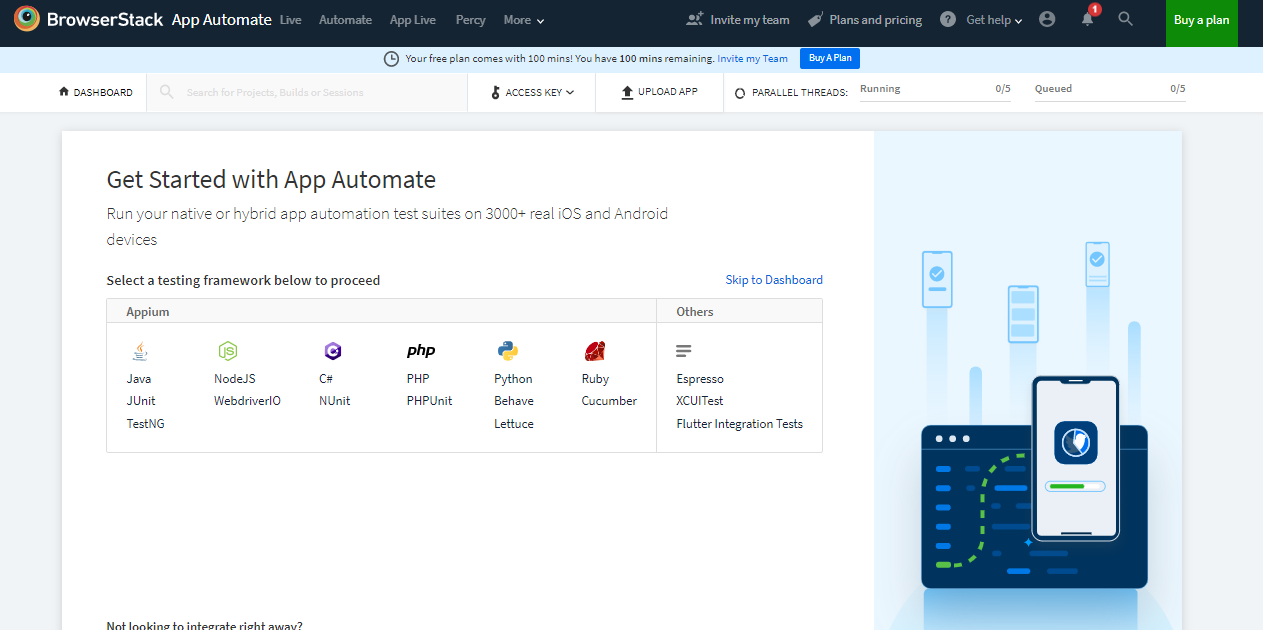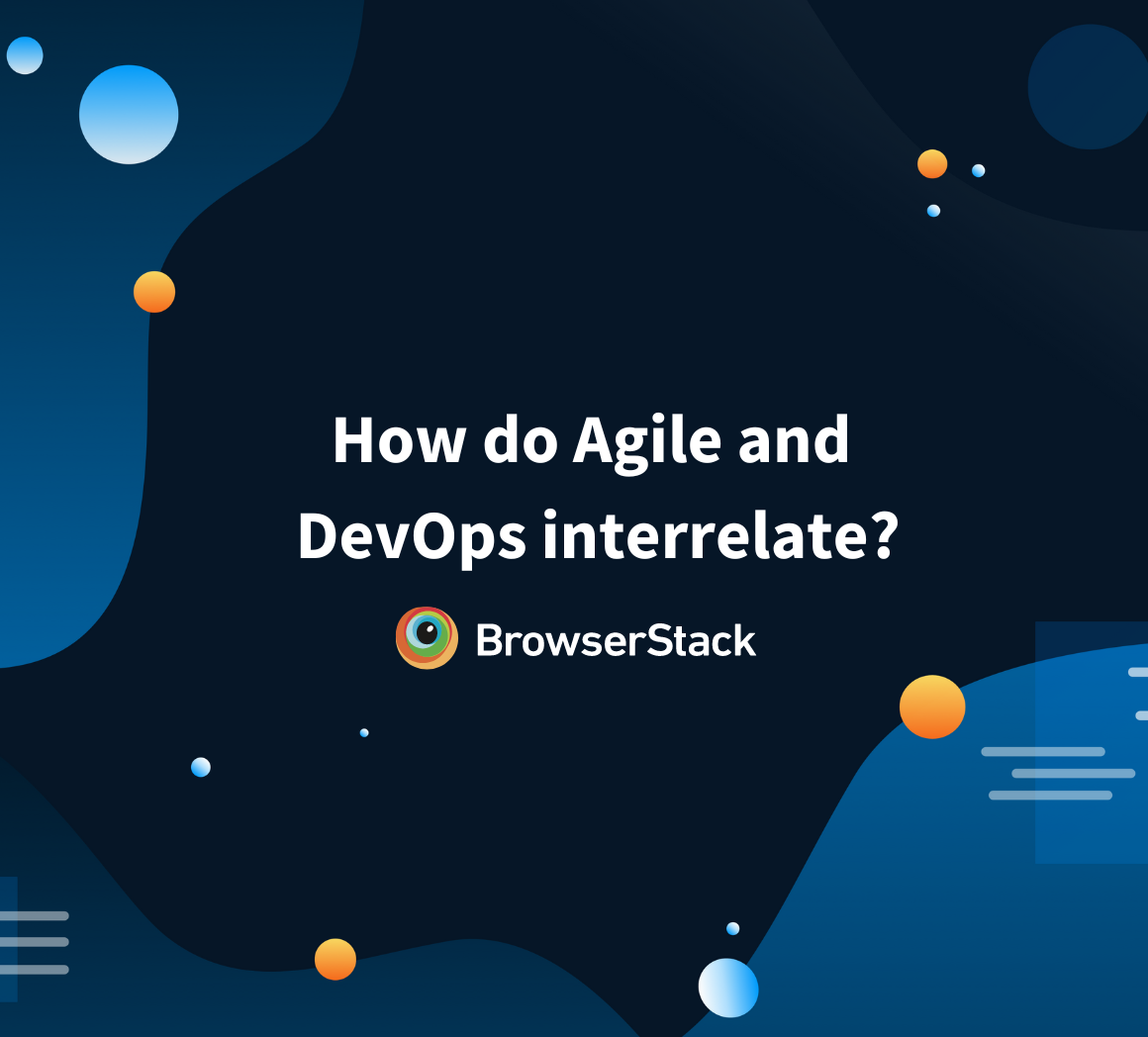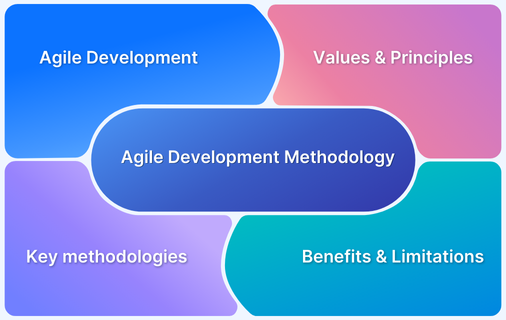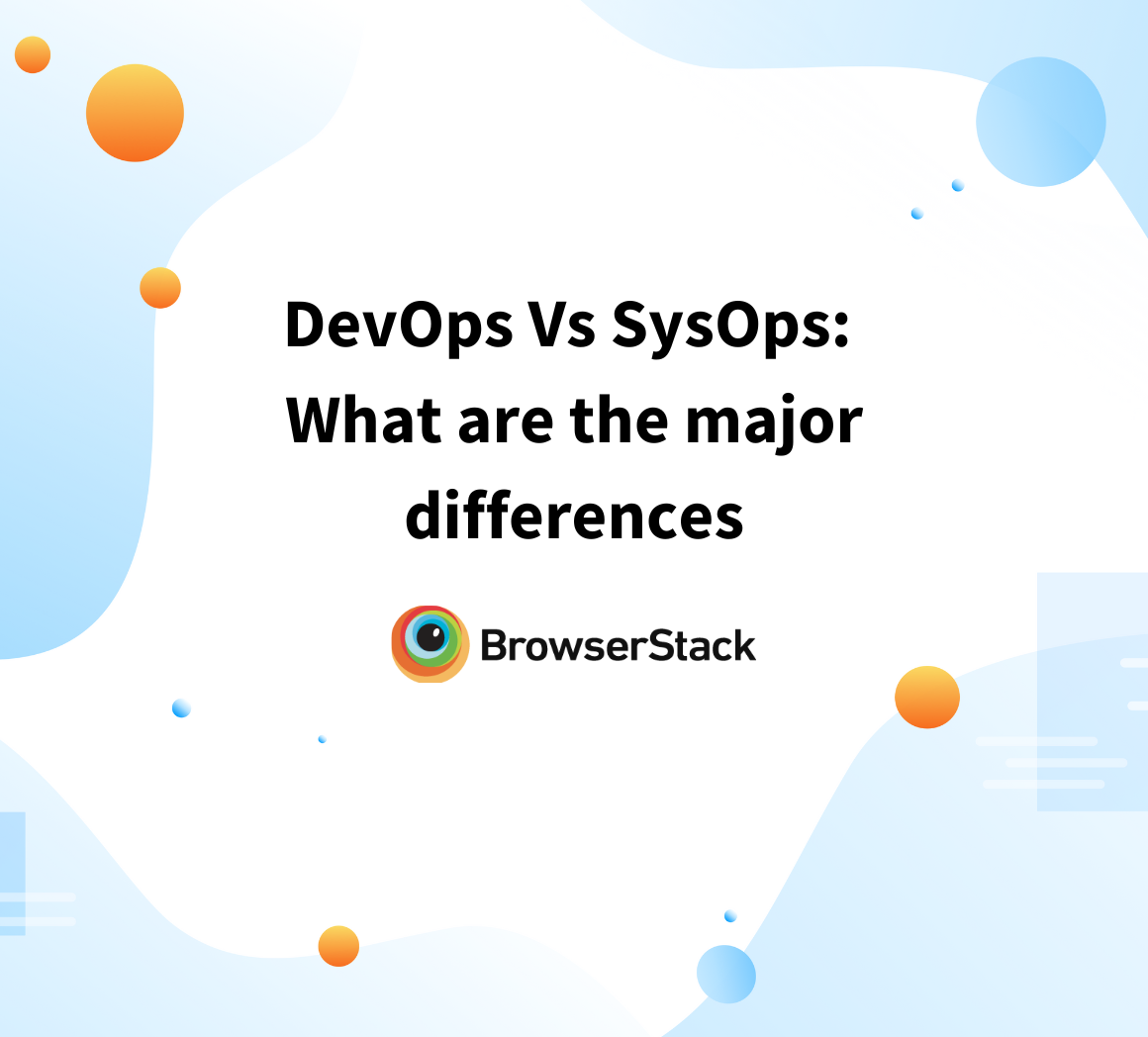Agile vs DevOps: What’s the Difference?
By Shormistha Chatterjee, Community Contributor - February 11, 2025
Agile focuses on improving software development through collaboration, iterative progress, and customer feedback. However, it does not address the operational challenges of deploying and maintaining software. This limitation gave rise to DevOps, which prioritizes integrating development and operations through automation, continuous delivery, and efficient workflows.
While Agile is centered on the how of development, DevOps emphasizes the how of deployment and maintenance.
This article provides a detailed overview of the differences between Agile and DevOps and highlights how these methodologies address distinct yet interconnected aspects of the software lifecycle.
- Agile vs DevOps: Differences
- What is Agile Methodology?
- What is DevOps Methodology?
- Understanding the Differences between Agile Methodology and DevOps
- Agile vs DevOps: Key Similarities
- When do DevOps and Agile work together?
- Why implement Agile and DevOps methodologies together?
- Useful Resources for Agile Methodologies
Agile vs DevOps: Differences
Agile and DevOps serve distinct roles in the software development lifecycle.
DevOps focuses on integrating development and operations, with teams actively involved in building, testing, and deploying software. Agile, on the other hand, emphasizes iterative processes, collaboration, and adaptability in software development.
The table below shows a detailed comparison between both.
Agile vs DevOps Comparison Chart
| Parameters | Agile | DevOps |
|---|---|---|
| Priorities | Agile methodology concentrates on continuous modification. | The DevOps method concentrates on recurrent testing and delivery. |
| Team size | The team is small at the core of Agile. | Relatively big team size as it includes all the stack holders. |
| Scope | Agile assists in managing complicated projects. | DevOps’s central idea is to manage end-to-end engineering procedures. |
| Execution | Agile methodology can be executed within a set of tactical frameworks such as a scrum, sprint, and safe. | DevOps concentrates on collaboration, so it does not have any commonly acceptable framework. |
| Team skill set | Training all team members to have an extensive range of equal and similar skill sets. | Splits and spreads the skill set between the development and operation teams. |
| Duration | Agile development is handled in a set of “sprints.” | DevOps strives for benchmarks and deadlines with maximum releases to deliver code to production every day or daily few hours. |
| Feedback | Feedback is given by the client. | Feedback comes from the internal team. |
| Emphasis | Focuses on software development methods for developing/ designing software. When the software is released, the agile team won’t care what occurs to it. | DevOps is simply about taking software products ready for launch and deploying them in a trustworthy and safe manner. |
| Goal/ Objective | It addresses the gap between client necessity and development & QA teams. | It addresses the gap between testing plus development and Ops. |
| Communication | Scrum is a very common methodology for executing Agile software development. Every day scrum meeting is performed. | DevOps communications include specs as well as design documents. It is crucial for the operational team to completely comprehend the software launch and its network/ hardware implications for effectively running the deployment procedure. |
| Challenges | Requires teams to be extra productive, which is arduous to match every single time. | Requires development, tests, and production environments to organize work. |
| Quality | Agile produces perfect app suites with the desired necessities. It can easily be accepted as per the modifications made on time during the project life. | DevOps, together with automation and earlier bug removal, contributes to forming great quality. Developers have to follow Architectural and Coding best practices to manage quality standards. |
What is Agile Methodology?
Agile methodology is a flexible software development approach that emphasizes continuous iteration, collaboration, and incremental progress.
It breaks projects into smaller sections for iterative development and testing, often using frameworks like Scrum, Kanban, or XP.
Agile Manifesto
The method is defined by the Agile Manifesto, twelve principles that lay the foundation and standards of “working agile.” There are 4 core values at the core of agile software development:
- Individuals & interactions over tools and procedures- The philosophy emphasizes valuing every single team member and fostering a stimulating and healthy work environment. It encourages continuous communication between co-workers to increase efficiency.
- Customer association over contract negotiation- Continuous development counts work together with the customer regularly. Instant response guides the project in the direction which will ultimately give the finest outcomes.
- Working software over complete documentation- Documentation can’t stand in the mode of delivering software. Earlier, every single project had to commence with descriptive documentation of the necessities and prospects of the developing software.
- Responding to modification over following a plan- Alterations made a mid-project requirement to be readily accepted as they can assist with the product’s entire success. Accepting new circumstances and embracing fresh traits is one of the key differences between waterfall & agile.
Benefits of Agile Methodology
Below are the key benefits of Agile Methodology:
- Enables quicker releases of usable products, shortening time-to-market.
- Adapts easily to changing customer needs and market conditions.
- Promotes close communication between teams and stakeholders.
- Incorporates regular feedback to ensure the product meets user expectations.
- Iterative development allows for real-time issue identification and resolution.
- Frequent testing and updates ensure continuous improvement in the product.
- Encourages teamwork, accountability, and shared ownership.
- Early identification of issues minimizes rework and optimizes resources.
What is DevOps Methodology?
DevOps is a software development practice aiming to bring development (Dev) and operations (Ops) together. It is a conception that fosters a culture of teamwork between these two teams from the preliminary design stage straight through to the product launch.
The intent is to allow communication between the QA teams so that they can build, test, and launch software products rapidly and with better speed and efficiency.
DevOps Principles
The evolution to this modern culture is impossible without understanding the core values that drive it. It necessitates a modification of mindset within the software development and the operations team, which motivates them to work as a united front.
The Three Ways of DevOps
The Three Ways of DevOps emphasize core principles for effective implementation:
- Systems Thinking: Recognizing software applications as complex systems, focusing on end-to-end workflow optimization.
- Amplifying Feedback Loops: Enhancing bidirectional communication to ensure continuous improvement and better team collaboration.
- Cultural Change: Fostering a culture of experimentation, learning, and adaptation to drive innovation and resilience.
The following principles are the base that steers the engineering procedure in a DevOps environment:
- Version Control- Software Developers submit code modifications to a central repository daily. Before submitting code to the master branch (master repository), each code should be verified. To expedite collaboration, other software developers can track modifications.
- Collaboration- One of the chief objectives of DevOps is to foster partnership and opinion sharing. Both Development & Operations require to proactively communicate and share a response to manage an effective DevOps pipeline.
- Continuous Integration- Members of the software development team incorporate their code in a shared repository, numerous times a day. Every developer segments the function into manageable, small chunks of code & identifies potential merge bugs and conflicts rapidly.
- Continuous Testing- Such a strategy counts testing as much as possible in each phase of software development. Automation testing gives valuable feedback and a threat assessment of the procedure at hand.
- Continuous Deployment- The major portion of DevOps is automating procedures to fasten production. The continuous deployment includes automating releases of slight updates that don’t pose a substantial risk to the current architecture.
- Continuous Delivery- The code is constantly integrated and constantly delivered to the end-user. Lesser contributions let quicker update releases, a critical factor for customer satisfaction.
- Continuous Operations- The DevOps team always functions on updating software with small but recurrent launches. That is why DevOps necessitates continuous observing of performance. Its chief objective is to prevent downtime & accessibility issues during code release.
Also Read: Automated Testing with Azure DevOps
Benefits of DevOps Methodology
DevOps functions on a cross-functioning technique that makes certain that it delivers in the fastest frame of time and enhances security and flexibility.
Here are some of its key technical benefits over Agile:
- Enhances speed, security, and flexibility in the development lifecycle.
- Reduces errors and delays through smooth integration between development and operations.
- Improves adaptability to changing demands while maintaining security through automation.
- Enables faster deployment and reduces time-to-market.
- Facilitates quick feedback and continuous improvement.
- Boosts productivity and communication through cross-functional collaboration.
- Easily identifies and addresses bottlenecks in the development process.
- Ensures stable, consistent software delivery and an efficient working environment.
Irrespective of the type of DevOps toolchain a company uses, the ultimate goal of DevOps procedure requires to use of the right tools to address the crucial stages.
Understanding the Differences between Agile Methodology and DevOps
Here are the key differences between Agile and DevOps:
- Priorities: Agile focuses on continuous modification of software, while DevOps concentrates on continuous testing and deployment.
- Team Size: Agile teams are smaller and self-organized, whereas DevOps involves larger teams including development, operations, and other stakeholders.
- Scope: Agile is used for managing complex projects through iterations, while DevOps manages end-to-end processes across both development and operations.
- Execution: Agile follows tactical frameworks like Scrum or sprints, while DevOps has no standard framework and focuses on collaboration across teams.
- Feedback: Agile gets feedback from clients, while DevOps emphasizes internal feedback from development, testing, and operations teams.
- Communication: Agile uses daily meetings like scrum for communication, whereas DevOps requires clear communication of specifications, designs, and deployment procedures across teams.
- Challenges: Agile requires teams to maintain productivity, which can be challenging, while DevOps needs alignment between development, testing, and operations environments.
- Quality: Agile focuses on delivering quality features based on user needs, while DevOps ensures quality through automation and early bug detection.
Agile vs DevOps: Key Similarities
Here are the key similarities between Agile Methodology and DevOps:
1. Emphasis on Automation and Testing
Agile and DevOps are focused on accomplishing stability. They ensure so by dynamically operating in a secure, fast, & quality-assessed environment. Both methods achieve this through the incorporation of a great deal of testing on a repetitive basis.
They are similar in their opinions on automation to bring extra security and flexibility to the implementation procedure.
2. Paves the way for Robust Partnerships
Although Agile and DevOps might have countless differences, both lay an excessive amount of importance on building a collaborative workplace, wherein team members stay linked to share info, rapidly detect issues, and troubleshoot issues/ bugs conveniently and easily.
There is an enormous emphasis on connections among individuals and team members to become highly efficient, productive, and responsive to change.
3. An Inclination toward Business Output
Both Agile and DevOps function in tandem toward accomplishing one collective objective for businesses — the highest productivity. Agile and DevOps share a similar business-centric approach. Executing the Agile method in the software development procedure gives QA teams the time to focus on a solo target, leaving room for them to be more productive and save time.
Conversely, integrating the DevOps culture results in rapid delivery and releases without hampering business procedures.
4. Draws Inspiration from Lean Philosophies
Agile and DevOps share a mutual ground in deriving their practices from the Lean philosophy. The Lean philosophy supports Agile and DevOps to standardize their communication procedure and expedite smooth interactions among team members to create a productive and healthy work environment.
When do DevOps and Agile work together?
DevOps can be assumed as an advancement of agile practices, or as a missing piece of agile. It’s a strength to take the innovations of the agile tactic and apply them to operations procedures. Similarly, it’s a missing part of agile, as certain principles of agile are simply realized in their complete form when DevOps approaches are employed.
For instance, there are several references to software’s continuous delivery in agile documents, but as delivery pipelines incorporate operations concerns, continuous delivery is generally regarded as a DevOps approach. Amplifying DevOps feedback loops necessitates enhanced communication between and across teams. Agile, especially scrum, helps assist this communication through its numerous ceremonies, such as planning meetings, daily standups, and retrospectives.
Why implement Agile and DevOps methodologies together?
Continuous commitment of operation team members with a software development team all through the solution development lifecycle, the approach to keep everybody well-informed, the orientation of project management to accept and transfer responses from everybody, and other techniques of enhancing product development efficiency are being integrated into the strategies of diverse organizations worldwide.
Implementing DevOps and Agile methodologies together, as finding the very effective means to sustain, measure, and enhance success is always a priority. The crucial reasons are:
- DevOps tools will assist with the QA team’s agile initiatives.
- The culture of responsibility and freedom.
- CI/CD as a fragment of the agile development procedure & automation gives a lift to speed.
- The DevOps team can efficiently communicate the technical facets needed to attain the final result to other stakeholders and the product owner.
- Continuous tests become a crucial section of the development process.
- Agile metrics will help compute the effectiveness of using DevOps in Agile.
- The DevOps team existing at everyday stand-ups, sprint planning, and assessment will help certify that all product alignments and improvements are approached convincingly.
Read More:How do Agile and DevOps interrelate?
Useful Resources for Agile Methodologies
- Agile Development Methodologies: An Essential Guide
- All about Agile SDLC (Software Development Life Cycle)
- What is Agile Testing Know About Its Life Cycle, Types, and Metrics
- What is Agile Testing Quadrants: Why & How to Use It
- What is a Test Plan in Agile?
- How to Write Software Requirement Specifications in Agile
- Agile Testing Metrics that Every Tester Must Know
- 11 Agile Testing Challenges and its Solutions
- Debunking Myths about Agile Testing
- How BDD and Agile Together Make Testing Efficient
- Continuous Integration in Agile
- What does continuous delivery mean in agile?
- Risk Based Testing Approach for Agile Teams
- How to run Regression Testing in Agile Teams
- Role and Responsibilities of QA managers in Agile organizations
- Agile vs DevOps: What’s the Difference?
- Difference between CI and CD, Agile and DevOps
- Why Automation Testing is at the Centre of Agile Development
Conclusion
The objectives of Agile and DevOps are the same: to enhance the quality and speed of software development, and it makes slight sense to talk about one without the other. Various teams have found agile method helps them extremely, while others have struggled to realize the rewards promised by an agile method. This might be due to several reasons, counting teams not fully understanding or correctly executing agile practices.
- It may also be that incorporating a DevOps practice will assist fill the gaps for companies that struggle with agile and aid them to have the success they were eager for.
- Successful DevOps execution relies heavily on automation.
- It is of utmost significance to use the right test automation frameworks, established in the accurate toolchains to automate huge sections of the development & deployment pipeline.
However, DevOps is not merely about tools. It begins with an alteration in mindset among all parties involved and utilizing a perfect platform to execute that mindset in software testing.
With BrowserStack suite of products like Live, Automate, App Live, App Automate & Percy, teams can look achieve its Agile and DevOps goals.





